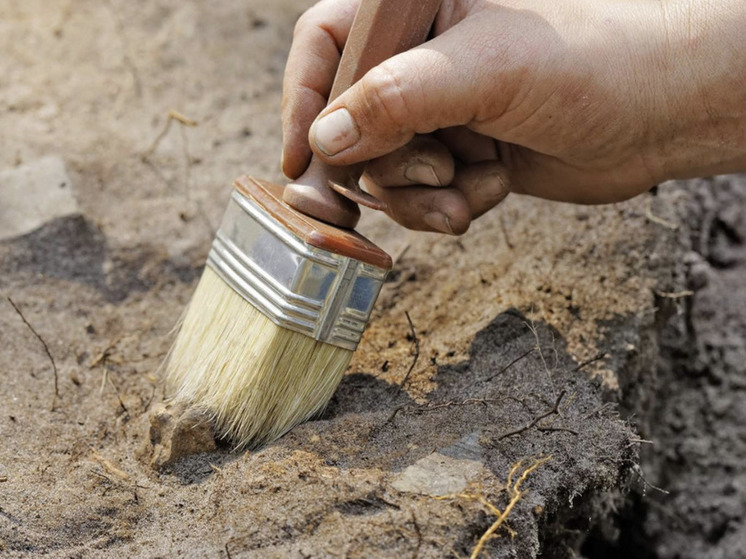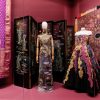Modern technology is increasingly allowing people to learn about the past
New archaeological tools continue to provide archaeologists with innovative ways to study the past. These achievements bring experts closer than ever to understanding the world of the Vikings.

Science loves Vikings. For example, NASA's Mars mission in the 1970s paid homage to the Vikings, and Bluetooth wireless technology was named after the Viking king of Denmark and Norway, Harald Bluetooth. The Bluetooth symbol also comes from Viking runes. Science has become important in uncovering Viking archaeology, and new archaeological tools have allowed us to better understand the Viking world.
Trelleborg Fortress, located in Denmark, is a circular fortification divided into four squares. Inside each square there are long houses. The fortress itself is an archaeological wonder, but the more scientists excavate the fortress, the more exceptional the monument turns out to be.
King Harald Bluetooth organized defensive fortifications throughout the Viking world to maintain power in the 10th century. Excavations in Zealand in 1938-1940 revealed a fortification associated with the reign of the Danish king and 157 buried people. But who were these people?
Archaeologists have turned to a technique called strontium isotope analysis—a naturally occurring element found in most rocks, but its isotopes vary depending on the geology.
In children, strontium isotopes accumulate in tooth enamel, which does not change after childhood, Therefore, archaeologists can use these types of isotopes to determine where a person was born or spent his childhood. Strontium also accumulates in bones, but evolves over seven to ten years. Thus, archaeologists can also assess the strontium isotope content of bones to understand whether a person migrated late in life.
Archaeologists selected 48 people from the Trelleborg fortress burial ground. By analyzing their tooth enamel, scientists discovered that this group of people came from a variety of places. More than half of the people surveyed spent their childhood outside of Southern Scandinavia.
The find surprised archaeologists, who had expected that most of the people buried here were from Denmark. Based on the results, experts suggested that many people came from Norway, the Baltic states and other foreign areas to join the army during the reign of Harald the Blue. It seems that many never returned home.
In the 1920s, a ship was discovered off the west coast of Norway. Farmers excavating a peat bog have found the remains of several sailing ships. Analysis revealed that one of the vessels was a ship built from clinker, and the other was a small boat built from clinker. They became known as the ships of Kvalsund. Based solely on the ships, archaeologists had several questions. When were the ships built and by whom?
Dendrochronology is an archaeological technique also commonly referred to as tree-ring dating. Hidden within the trees are concentric tree rings that scientists can assign calendar dates to. The «Men of the North» cut down trees for several types of artifacts, including game boards, chests, caskets, and, most notably, ships. For the Kvalsund ships, archaeologists have used dendrochronology to understand when they were built and how they fit into Norway's Iron Age shipbuilding history.
Dendrochronology dated the ship to around 780-800 AD. This date supports archaeologists' interpretation that the ship was buried as a cult offering during the transition to the Viking Age. This reflects the social and technological changes in the Scandinavian world during this period.
The Vikings were masters of various crafts. They often used animal bones to create intricate objects, making combs, playing pieces, pins, needles, and musical instruments from the bones of large and small animals. While these artifacts provide insight into what was important in the Viking world, they also show what resources were available to the medieval Norse.
The bones from which these artefacts were made also indicate how and where the Normans spent their time. Archaeologists can identify animal body parts and even species by analyzing bones. Once bones are carved into new objects, this becomes more difficult, so archaeologists have turned to science to overcome this obstacle.
Artifacts made from animal bones, fur, and shells preserve the creature's collagen and proteins. Scientists can extract collagen and other proteins from artifacts and determine what species of animal the artifact was made from using zooarchaeology through mass spectrometry, a type of peptide mass fingerprinting that allows archaeologists to identify animal species by their molecular fingerprints.
Archaeologists have used enlarged images to better understand many Viking Age artifacts. Game items from Sweden were analyzed using enlarged images and were found to be made from whalebone. Of the baleen game items tested, only one species of whale was identified: the endangered North Atlantic right whale.
Based on these finds, archaeologists theorize that Vikings hunted whales long before the Viking Age and established trade routes that were later used by medieval Norwegians. Archaeologists have also used magnification to evaluate hair combs made from deer antlers. Enlarged images have shown that the Normans were making combs from deer antlers by at least 780 AD. This explains that the «Men of the North» used long-standing trade routes in the southern North Sea. From whale hunting to collecting antlers, enlarged images continue to shed light on the rich life of the Vikings.
Trouble seemed to follow the Vikings throughout the medieval world. The Norwegian rulers found it necessary to prepare for attacks on their kingdoms by building large fortifications. The largest of these fortresses is called Aggersborg in Denmark. It consists of both a ring fortress and a settlement that predates the construction of the fortress.
Although archaeologists have long known the location of Aggersborg Fortress and its historical significance, they had no idea how large or small the fortification actually was or settlement. It was impossible to excavate the entire fortress, and archaeologists needed a way to get an idea of what awaited them underground.
Geophysics offers archaeologists a set of geodetic methods. Using geophysical instruments, archaeologists can detect underground features that are not visible on the surface of the earth. One type of geophysical survey is ground penetrating radar, a radar that transmits electromagnetic pulses into the ground. These pulses strike the ground and materials in the ground, such as walls or pipes, and cause reflections.
Scientists measure the time it takes for these reflections to return to the point of transmission. This time gives archaeologists an idea of how deep the object is and how many interesting places may lie underground. Archaeologists can then begin excavations to determine what these objects might be.
At Aggersborg, ground penetrating radar combined with other geophysical techniques have revealed preserved wooden rampart structures and sunken building elements. The study gave archaeologists insight into everything they had yet to learn about the Viking ring fortress.
The Viking Age fascinates scientists for many reasons. One area of interest is the Viking connection to Europe, the Baltic and the Middle East. Scholars have questioned whether the Vikings pioneered far-reaching trade routes, or whether they simply took advantage of routes that preceded their forays into the medieval world. To answer this question, archaeologists needed to be able to analyze artifacts and excavation sites to accurately determine the chronology.
In archeology, there are two types of dating: absolute and relative. Absolute dating measures the physical properties of artifacts to determine the age of an object. Relative dating is a less precise method of dating that allows archaeologists to date an artifact in relation to other objects or cultural features.
For absolute dating, archaeologists use radiocarbon dating. The earth is full of carbon isotopes. Stable isotopes of carbon are known as carbon 12. Unstable isotopes of carbon are known as carbon 14. When something dies, isotopes of carbon-14 begin to decay at a constant rate. Scientists can count the amount of stable carbon isotopes and carbon-14 isotopes in objects. They estimate the ratio between stable carbon isotopes and carbon-14 isotopes to estimate age.
On the other hand, archaeologists have used relative dating when assessing the stratigraphy of the Viking trading center of Ribe. Stratigraphy is based on the law of superposition, which states that the earth is formed in layers, and the lower layers are formed before the upper layers of the earth. Thus, the lower layers are older.
Combining these approaches, archaeologists have found evidence in beads, brooches and combs that Viking Age sea trade routes existed long before the Normans raided Lindisfarne. Thus, radiocarbon dating, in combination with other methods, has helped archaeologists revise long-standing historical chronologies.
Trade was crucial for the Vikings. On the island of Bjerke on Lake Mälaren, the Vikings founded a trading center called Birka. Many people buried in and around the trade center were buried with rich grave goods. In one grave, archaeologists found no traces of a body, but they did find clothing, brooches, scissors, a needle case, glass, rock crystal and carnelian beads, and a ring. The ring consisted of purple amethyst glass with a silver edge.
Archaeologists took a closer look at the ring using a scanning electron microscope. A scanning electron microscope creates images using electrons instead of light. A scanning electron microscope revealed an inscription on an amethyst ring from Birka. The ring says «Allah» and the inscription suggests that some of the Vikings were Muslim.
In another grave at Birka, archaeologists discovered the grave of a warrior buried with an impressive cache of weapons and other grave goods. The body lay surrounded by a sword, an axe, a knife, two spears, two shields and 25 arrows. Along with his weapons, the warrior was buried with bone figurines of game and two horses.
Archaeologists initially assumed that the grave belonged to a male warrior. Women warriors have existed throughout history, but male warriors are more common. Over the years, archaeologists began to wonder if the Viking warrior was a woman. This time, scientists turned to genomics to investigate this question.
Genomics is the science of mapping genomes, and with the help of genomics, archaeologists were able to map and estimate the DNA of the Birka warrior. The results of the study showed that the warrior had two X chromosomes and was born female.
The female Viking Age warrior from Birka highlights the diversity of life for women in the Viking Age. While many women lived a rural lifestyle centered around the home, many others moved to urban trading ports where they worked in the craft industries. The Viking Age saw the emergence of Scandinavian queens, Scandinavian soothsayers and — as proven by science — Scandinavian warrior women.
Science has helped archaeologists shed light on the complexity of women's lives in the Viking Age and corrected erroneous interpretations. As scientific methods continue to advance, archaeologists can expect to learn more about the Viking world.


























































Свежие комментарии